"Russian trace" in the Scandinavian game saga
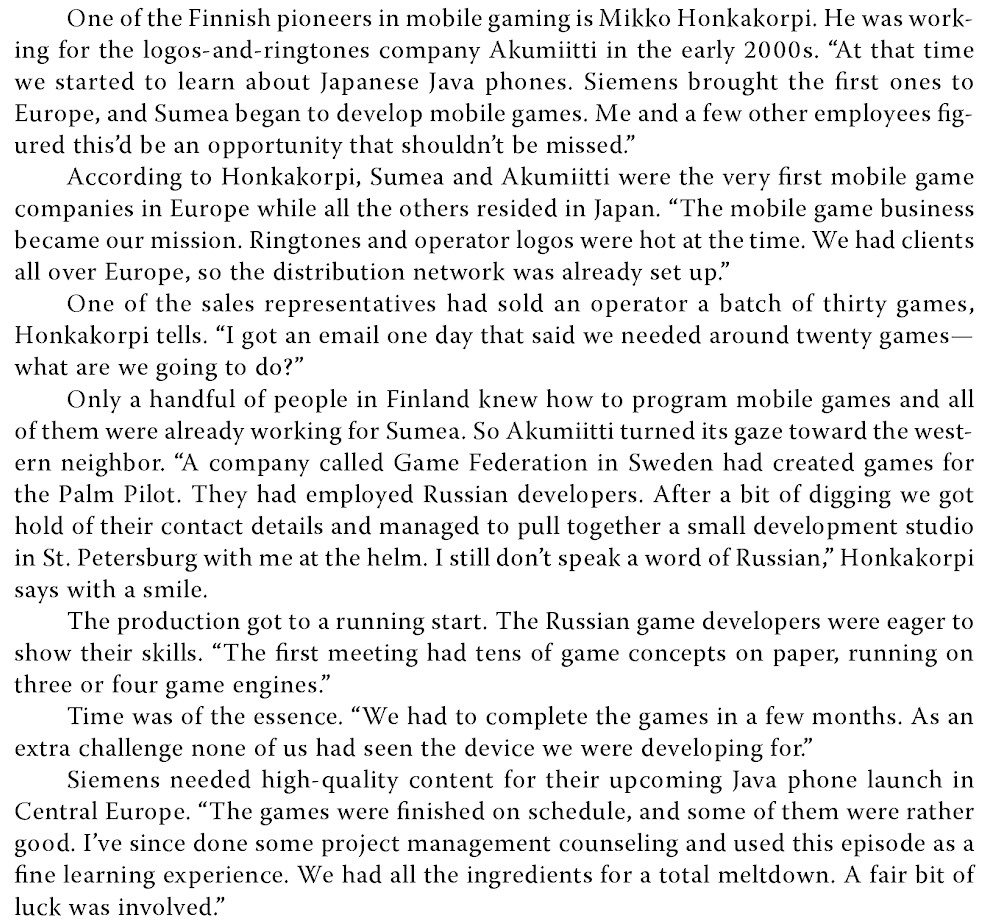
“One of the Finnish pioneers in the mobile gaming industry is Mikko Honkakorpi. He worked for Akumiitti (a mobile content provider) in the early 2000s. “At that time, we started learning Japanese Java phones. Siemens brought the first such devices to Europe, and Sumea began developing mobile games. I and several other employees realized that this is an opportunity that we should not miss. ”Since I had some relation to these projects, I decided to slightly clarify and supplement the story of a famous Finnish specialist, telling how the projects looked at the level of execution. I will start in order and in this post I will try to describe the Swedish project mentioned in the Finnish book.
According to Honkakorpi, Sumea and Akumiitti were the very first mobile gaming companies in Europe, while the rest were located in Japan. “Mobile gaming has become our mission. Ringtones and logos were hot at the time. We had customers all over Europe, so the distribution network was already prepared. ”
One of our sales reps sold a package of thirty games to one of the operators, Honkakorpi says. “Once I received an email saying that we need about twenty games - what are we going to do?”
')
Only a handful of people in Finland knew how to write mobile games and they were all already hired by Sumea. So Akumiitti turned its gaze to its eastern neighbor. “One Swedish company called Game Federation has already had experience developing games for the Palm Pilot. To do this, they hired Russian developers. After a small “excavation”, we got the contacts of these developers and were able to bring them together in a small game studio in St. Petersburg, which I headed. I still don’t know a word of Russian, ”said Honkakorpi with a smile.
The production process has started. Russian developers sought to show their skills. “At the first business meeting, we already had paper sketches of dozens of games for three or four game engines.”
Time was running out. “We had to pass all the games in a few months. As an additional challenge, none of us had ever seen a device for which development was to be conducted. ”
Siemens needed high-quality content to launch its new Java phone in Central Europe. “The games were completed on schedule and some of them were quite good. Since then, I have used this episode as a good teaching example in advising on project management. We had all the ingredients for a complete disaster. It took a pretty good amount of luck. ”
Swedish project for Game Federation
In 2001, the Swedish company Game Federation AB (their website www.gamefederation.com is currently available only through online archives) decided to present its new technology for organizing cross-platform gaming sessions called GEX and not somewhere, but on the world exhibition E3 2001. What fell into my hands in the form of documentation on the platform, more like a slide presentation and a couple of Java interfaces that were supposed to be implemented. As a demonstration, the J2ME mobile platform was chosen (as the base unit of the Motorola A008, and not the Palm Pilot as written in the book, although of course they can sometimes be confused) and an ordinary PC running Windows. The Swedes had a staffed team of back-end developers, of those with whom I actively communicated were two - Christian Anderson (Mark Andersson) and Markus Persson (Markus Persson, yes, this is the one who later became known to the whole world as Notch).
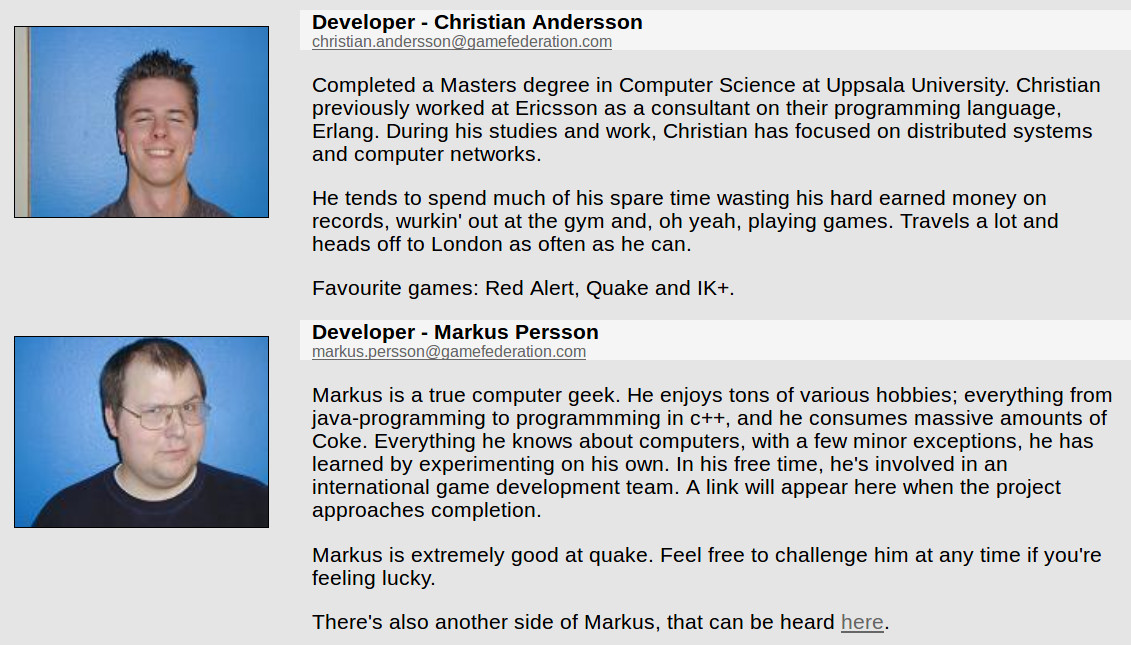
While everything was caught up with the server part, there was clearly not enough qualified hands on the mobile and desktop directions and they began to look for outsourcers, including in Russia, finding them in the face of the recently (by that time) organized Rus company in St. Petersburg. -Soft (the organizer was Alexander Dymov who had recently returned from Ireland, the organizer was mainly busy with the launch of the ORC Software St. Petersburg office). As a negotiator for the Russians, the Swedes sent Australian Mark Pinan (Mark Pinan), who discussed the details of the project with the leadership of Rus-Soft (his favorite exclamation was brilliant!). At that time, I worked for the St. Petersburg branch of the German company Concept-Software GmbH, where we were slowly engaged in Java projects and Java applet games, which played a part in Alexander’s decision to invite me to the role of Java developer in the Swedish project. He also found a programmer Sergey Kuligin, experienced in game development of C ++, and two very cool game artists with vast experience - Vladimir Chernysh and Dmitry Kholodov.
Before E3 2001, it was about three months and the choice of which game we would be implementing, the Swedes put on us, their task was disassembling with the server part, which was still damp. The experienced part of the team was a little indignant at such tight deadlines, but I was referring to the not very experienced part and I was rather surprised by the thought that three months would not be enough. In the end, it was decided to “gash” the good old “Sea Battle” (in English called “Battle ships”) because the game was both simple, turn-based, available for implementation simultaneously on a weak mobile device and on a powerful desktop and had the opportunity to have a different entertainment level depending on the platform. The work began in early March and should have been completed by mid-May, since E3 2001 was held May 16-18, 2001.
My part of the work was complicated not only by the fact that I didn’t have experience with the new J2ME technology at that time, but also by the fact that the target mobile device (which had new, breakthrough for those times GPRS technology for packet data) was in a single copy and was located in the Motorola laboratory in Stockholm (Sweden), so that all testing on a real device took place in the form of periodic visits to the laboratory by members of the Swedish team and running on the experimental device software codes obtained from Russia. At that time, Sun had already published its J2ME WTK with emulation capability, so I made a profile for it that, in my opinion, imitated A008 and developed “by eye” in emulation mode.
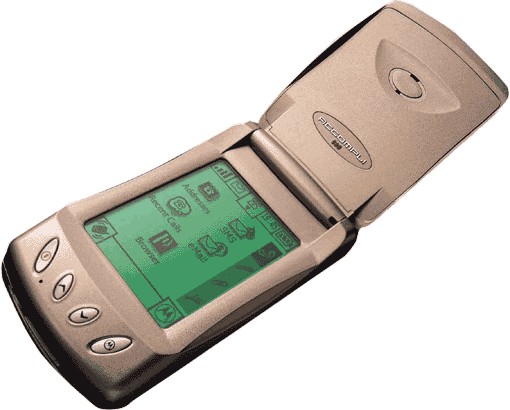
With the desktop version, everything was more fun and the artists developed a stunning concept of the game, which, despite its two-dimensionality, was launched under DirectX3D using various effects and the entire program part was written accordingly in C ++. There was also a small curious personnel moment on the project. Once I came to the office, I met a student who was unfamiliar to me there, about whose participation I had never heard before (Alexander Dymov also looked surprised when he found out about a new team member). He worked on the C ++ part of the PC version. It turned out that it was Sergei Kuligin, who was simultaneously with the development of a teacher from a St. Petersburg university, attracted one of his students to work. Looking ahead, I must say that the experiment involving student labor turned out to be conditionally successful. The student had little experience in the gaming field, and Sergei still had to finish a lot himself. Sometimes it was fun to see artists explaining to a student how to place sprites of ships on the playing field, so that they would not overlap each other.
Since the back-end part was developed in Java with its client API, we decided to make the communication part of the PC version also in Java, for which we wrote a network module that connected to C ++ code via JNI (Java Native Interface). We were all not ashamed to generate ideas related to the game, in particular, from my proposed creative solutions for the desktop, our artists took the idea of drawing dead fish bobbing and swinging on the waves in the place of blunders. The soundtrack of the game was made by the sound engineer who was found by Vladimir Chernysh (I do not remember his name, because I came across him once or twice in total), the melody of the famous song about the cruiser Varyag was inserted as the background theme of the game.

In general, the project went smoothly and everything was done on time and without any overloads (I even had enough time to time to play in the office on a powerful computer in the recently released demo version of Operation Flashpoint), the Swedes little by little licked their server part, running it around on a real application, and we were looking for ways to link the gameplay through their service and channels available for mobile devices. As the transport protocol, we chose the most neutral and versatile of the available ones — the HTTP protocol. It is funny, but in my search for how to organize data transfer, I unexpectedly “rediscovered” what was already invented elsewhere and was called web application model Comet, i.e. HTTP connection works in the mode when the web server writes data to the channel without a preliminary request. I had no idea what "advanced technology" I use, however, and our Swedes too, Marcus Persson then jokingly told me that "we will steal your idea." Everything related to the mobile application, including its design, lay entirely on me, so I partially had to draw the pixel graphics myself (since the experience was still with the ZX-Spectrum and BK-0010), and the “close-ups” in the form of a splash screen and final pictures were adapted from PC version.
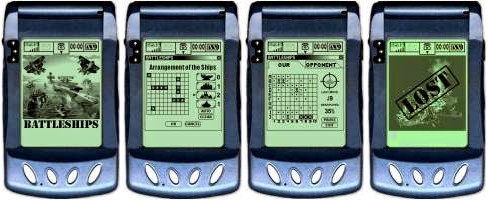
The finished product was presented to the customer, everything was fine, but an unexpected use case emerged about which we did not think about (and we were forgotten to tell about it at the beginning of the work). The customer wanted to present a gaming platform with a full cycle demonstration, i.e. starting with the demo download of the desktop client part on the PC, and it took us about 160 megabytes (!) (I remind you that 2001 was 2001 and 40 megabytes it was very significant for those communication channels). In general, the artists began to thin out the game animation (which was originally made simply monstrously smooth) and the client's PC size was reduced to 60 megabytes, which was more or less acceptable for the presentation. We did not have time to optimize and package the data (and such works would simultaneously raise the risks of product readiness), so we decided to dwell on the size of the truncated animation.
Suddenly another task from the customer fell on me. At some point it occurred to him that it would be nice to show not only a specially written demo client, but also the use of the GEX platform with some already known game. Vladimir Chernysh and Sergey Kuligin had wide connections among the St. Petersburg igrodels, and we began to contact various game studios. At first there was an unsuccessful contact with CREAT Studios, but then we successfully entered the studio Fireglow which at that time was making the famous game “Sudden Strike”. I (as the person responsible for the network part) was loaded into the car and sent to Vladimir Chernysh for an interview. This studio was located in a large St. Petersburg apartment in the old fund and it looked as though they had gotten into some kind of “raspberry”, a gangster-looking guy opened to us, empty bottles were on the floor, and I was talking to programmers who had problems with by hearing. We were shown the version of the game in development and gave a demo version for adaptation, although the developers were not very happy with the extra work and said - “why do we need your gaming platform if we already have everything working through DirectPlay!”. In the end, we managed to find a general solution that would satisfy everyone, so that the Swedes had another deme for their technology.

According to the Swedes, the presentation at E3 2001 was brilliant and they were able to generate market interest in their platform. After this project, I no longer had contacts with this company, but sometimes I opened their website to see how their business was going. The game “Battle ships” became a demo for their SDK, but then they stumbled upon the risks of claims from copyright holders of a similar brand and the name “Battle ships” on the screen saver was clumsily blurred and replaced by another. A couple of years later, their server technology was bought by someone and went into closed mode, and I no longer saw information about it in open sources. Vladimir Chernysh had ideas on organizing a gaming company under the roof of the Rus-Soft, but as I heard, after he began to play an important role in the game company Saber Interactive. The Swedish project was limited in time and all participants parted safely after it ended. I have never seen the mobile version of the game "live" on the "iron" device, only once several photos flashed in one of the Swedish electronic magazines devoted to mobile technologies.
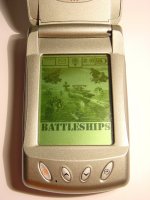
In the sequel, I will describe a project related to a Finnish company.
Source: https://habr.com/ru/post/458124/
All Articles